|
|
|
|
 CYCLE OF SUFFERING CYCLE OF SUFFERING
CYCLE OF SAMSARA
Other Translations
- Six States of Existence
- Six Roads of Reincarnation
- Six Paths of Transmigration
- Six Realms of Samsara
- Six Karmic Realms of Rebirth
- Six Directions of Reincarnation
- Six Destinies
- Wheel of Life (jump below)
Six Paths (Jp. = Rokudō 六道 or Rokudō-rinne 六道輪廻 or Mutsu no Sekai 六つの世界). Buddhist concept stemming from Hindu philosophies. Commonly translated in English as the “Six Realms of Karmic Rebirth.”
 Long before Buddhism's introduction to India, Hindu (Brahman) beliefs and traditions held sway. One important concept was "transmigration," more commonly known in the West as "reincarnation." It holds that all living things die and are reborn again. Your rebirth into the next life will be based on your behavior in your past life. This rebirth occurs again and again. When Buddhism emerged in India around 500 BC, it too stressed this Hindu belief in transmigration, one that still plays a major role in modern Buddhist philosophy. The modern Buddhist concept of Karma is also a byproduct of ancient Hindu beliefs in transmigration and reincarnation. Long before Buddhism's introduction to India, Hindu (Brahman) beliefs and traditions held sway. One important concept was "transmigration," more commonly known in the West as "reincarnation." It holds that all living things die and are reborn again. Your rebirth into the next life will be based on your behavior in your past life. This rebirth occurs again and again. When Buddhism emerged in India around 500 BC, it too stressed this Hindu belief in transmigration, one that still plays a major role in modern Buddhist philosophy. The modern Buddhist concept of Karma is also a byproduct of ancient Hindu beliefs in transmigration and reincarnation.
Among Buddhists, all living beings are born into one of the six states of existence (Samsara in Sanskrit, the cycle of life and death). All are trapped in this wheel of life, as the Tibetans call it. All beings within the six realms are doomed to death and rebirth in a recurring cycle over countless ages -- unless they can break free from desire and attain enlightenment. Further, upon death, all beings are reborn into a lower or a higher realm depending on their actions while still alive. This involves the concept of Karma and Karmic Retribution. The lowest three states are called the three evil paths, or three bad states. The Japanese spellings of all six, plus brief descriptions, are shown below:
- Beings in Hell. Naraka-gati in Sanskrit. Jigokudō 地獄道 in Japanese. The lowest and worst realm, wracked by torture and characterized by aggression.
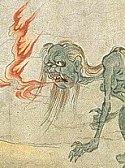 Hungry Ghosts. Preta-gati in Sanskrit. Gakidō 餓鬼道 in Japanese. The realm of hungry spirits; characterized by great craving and eternal starvation; see below photo/link for “Scroll of the Hungry Ghosts” (Gaki Zōshi 餓鬼草紙) Hungry Ghosts. Preta-gati in Sanskrit. Gakidō 餓鬼道 in Japanese. The realm of hungry spirits; characterized by great craving and eternal starvation; see below photo/link for “Scroll of the Hungry Ghosts” (Gaki Zōshi 餓鬼草紙)
- Animals. Tiryagyoni-gati in Sanskrit. Chikushōdō 畜生道 in Japanese. The realm of animals and livestock, characterized by stupidity and servitude.
- Asura. Asura-gati in Sanskrit. Ashuradō 阿修羅道 in Japanese. The realm of anger, jealousy, and constant war; the Asura (Ashura) are demigods, semi-blessed beings; they are powerful, fierce and quarrelsome; like humans, they are partly good and partly evil. See Hachi Bushu (8 Legions) for details.
- Humans. Manusya-gati in Sanskrit. Nindō 人道 in Japanese. The human realm; beings who are both good and evil; enlightenment is within their grasp, yet most are blinded and consumed by their desires.
- Deva. Deva-gati in Sanskrit. Tendō 天道 in Japanese. The realm of heavenly beings filled with pleasure; the deva hold godlike powers; some reign over celestial kingdoms; most live in delightful happiness and splendor; they live for countless ages, but even the Deva belong to the world of suffering (samsara) -- for their powers blind them to the world of suffering and fill them with pride -- and thus even the Deva grow old and die; some say that because their pleasure is greatest, so too is their misery. See also the Tenbu page and Hachi Bushu (8 Legions) page.

IMPORTANT NOTE: This topic is much more complicated than presented above. In Buddhism, there are actually 28 forms of existence in the Three Realms (Skt: Triloka). The three realms, starting from the lowest, are:
- Realm of Desire (Skt: Kamaloka, Kamadhatu). Beings from the six classes described above live in this realm. Here sexual passion and other forms of desire predominate.
- Realm of Desireless Form, Realm of Pure Form (Skt: Rupaloka, Rupadhatu). In this realm live 18 classes of gods. Here sexual desire and the desire for food fall away, but the capacity for enjoyment and pleasure continues.
- Realm of Formlessness, the Bodiless Realm (Skt: Arupaloka, Arupadhatu). In this realm live four classes of Deva. This is a purely spiritual continuum consisting of four heavens wherein one may be reborn.
The Shambhala Dictionary of Buddhism and Zen (ISBN 0-87773-520-4) has this to say about the various forms of existence:
“Between the various forms of existence there is no essential difference, only a karmic difference of degree. In none of them is life without limits. However, it is only as a human that one can attain enlightenment. For this reason Buddhism esteems the human mode of existence more highly than that of the gods and speaks in this context of the “precious human body.” Incarnation as a human being is regarded as a rare opportunity in the cycle of samsara to escape the cycle and it is a challenge and obligation of humans to perceive this opportunity and strive toward liberation (enlightenment)........Although the gods are allotted a very long, happy life as a reward for previous good deeds, it is precisely this happiness that constitutes the primary hindrance on their path to liberation, since because of it they cannot recognize the truth of suffering.” <end quote>
Only those who attain enlightenment, the Bosatsu (Mahayana), the Rakans (Theravada), and the Nyorai (Tathagata or Buddha, in both traditions) are free from the cycle of birth and death, the cycle of suffering, the cycle of samsara. To escape from the cycle, one must either (1) achieve Buddhahood in one's life or (2) be reborn in Amida Nyorai’s Western Pure Land, practice there, and achive enlightenment there; those reborn in this Pure Land are no longer trapped in the cycle of samsara, and can thus devote all their efforts to attaining enlightenment, or (3) practice the quick path of Vajrayana Buddhism (i.e. Tantric or Esoteric Buddhism).

Six Directions of Reincarnation, Six Realms of Samsara
Sino-Japanese = 六趣 or 六道眾生 or 六道, Tibetan = rikdruk
TABLE BELOW (Sino-Japanese Spelling, English Translation, Sanskrit Reading)
- 天道 or 天趣, Deva (Skt. = deva-gati)
- 人道 or 人趣 Humans (Skt. = manusya-gati)
- 阿修羅道 or 阿修羅趣 Ashura (Skt. = asura-gati)
- 畜生道 or 畜生趣 Animals (Skt. = tiryagyoni-gati)
- 餓鬼道 or 餓鬼趣 Hungry Ghosts (Skt. = preta-gati)
- 地獄道 or 地獄趣 Beings in Hell (Skt. = naraka-gati)
above from Dictionary of Chinese Buddhist Terms (by Soothill & Hodous)
Ten Stages From Hell to Buddhahood
There are nine states from Hell to Bodhisattva (Bosatsu). The highest level, the tenth level, is Buddhahood. After the six lower states come the four highest states, the “Four Noble Worlds.” These final four stages can only be achieved through deliberate effort -- in contrast, our movement in the six lower states is passive and blinded by false understanding. The Four Noble Worlds are:
- Learning -- seeks truth from teachings or experiences of others
- Realization -- seeks truth from one’s own direct perception of world
- Bodhisattva (Bosatsu) -- aspires to help all achieve salvation; there are six perfections (parmitas) that a Bodhisattva must cultivate in order to attain Buddhahood (learn more about parmitas); another term similar to Bodhisattva is Arhat (Sanskrit); this refers to the first disciples of the Historical Buddha; these disciples also attained enlightenment, soon after their teacher; the term Arhat is associated specifically with the Theravada school. For more on the Bosatsu (Mahayana tradition) click here. For more on the Arhat (Theravada tradition) click here. The Bosatsu and Arhat will surely attain Buddhahood, but for a time, they renounce the blissful state of Nirvana (freedom from suffering), vowing to remain on earth in various guises (reincarnations) to help all living beings achieve salvation.
- Buddhahood -- In Japan, those who have attained Buddhahood are called the Nyorai (Tathagata), Butsu, and Hotoke. Terminology here, or visit the Nyorai (Buddha) menu.
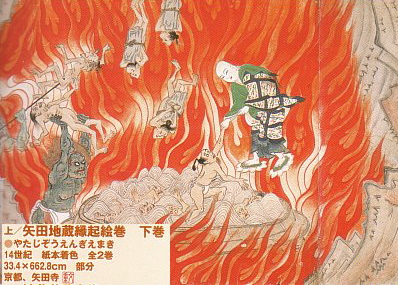
Jizō rescuing souls in hell, 14th century (detail)

Rokudou-e 六道絵
Below Text Courtesy JAANUS www.aisf.or.jp/~jaanus/deta/r/rokudoue.htm
Also occasionally read rikudou-e. Literally Six Paths. Paintings of the "six paths" (rokudou 六道) of existence are also called the "six realms" (rokushu 六趣) of reincarnation . According to Buddhist thought, all living beings are caught in an endless cycle of birth, death, and rebirth into one of the "six realms" being reborn up or down the scale according to the extent or lack of one's purity and good deeds in the previous existence. One can escape only by achieving enlightenment.
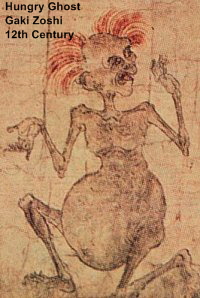 Described in numerous texts including the Lotus Sutra (HOKEKYOU 法華経) , the "six realms" are: Described in numerous texts including the Lotus Sutra (HOKEKYOU 法華経) , the "six realms" are:
- Hells (Sk: naraka, Jp: jigoku 地獄)
- Hungry ghosts (Sk: preta, Jp: gaki 餓鬼)
- Animals (Sk: tiryasyoni, Jp: chikushou 畜生)
- Bellicose demons (Sk: asura, Jp: ashura 阿修羅)
- Humans (Sk: manusya, Jp: jin 人)
- Heavenly beings (Sk: deva, Jp: ten 天)
Buddhists provide four additional realms for enlightened beings:
- Sravaka arhats (Jp: shoumon 声聞)
- Pratyeka buddhas (Jp: engaku 縁覚)
- Bodhisattvas (Jp: bosatsu 菩薩)
- Buddhas (Jp: hotoke 仏)
These can be combined with the six realms to form the "ten worlds" which are also depicted in painting (i.e., jikkai-zu 十界図). The concept of reincarnation in realms originated with Indian ideas of "five realms" (Sk:gati, Jp: goshu 五趣), which excluded the Ashura (Asura). Early Indian depictions of the five realms are found at Ajanta such as cave #17, late 5c. Illustrations of the six realms from 8-9c survive in China at Dunhuang 敦煌 (Jp: Tonkou).
The earliest Japanese depictions consist of hell scenes that are found in Nara period (8c) paintings related to Kannon Bosatsu 観音, such as the hairline engraving (kebori 毛彫) on the halo (kouhai 光背, Nara National Museum) of the principal image (honzon 本尊) of Nigatsudou 二月堂, Toudaiji 東大寺. From the 9-10c (mid-Heian period), Pureland (joudo 浄土) theologians vividly write of the torments of the "six realms" so as to make salvation by Amida Nyorai 阿弥陀 and the rewards of his paradise all the more desirable. Screens showing hell scenes were used in a ceremony called butsumyou-e 仏名会 at the imperial palace. The Essentials of Salvation (OUJOUYOUSHUU 往生要集), written by Genshin 源信 (942-1017) in 985, became very popular among Fujiwara nobles and greatly influenced the creation of pictures of the six realms. A set of fifteen hanging scrolls at Shoujuuraigouji 聖衆来迎寺 (Shiga prefecture 13c), visualizes Genshin's description of the rokudou, devoting four scrolls each for the realms of humans and hells. In the turbulent dislocations of the late 12c (end of the Heian period), religious patrons and artists seemed particularly interested in visualizations of the realms of hells and hungry ghosts. The Hell Scrolls (Jigoku zoushi 地獄草紙, 1180's, Tokyo National Museum and Nara National Museum) and Hungry Ghost Scroll, (Gaki zōshi 餓鬼草紙, 1180's, Kyoto Natioanl Museum) are well known, and sometimes the term "rokudou-e" in the narrowest sense of the term indicates these handscrolls (emaki 絵巻). From the Kamakura period, Jizō Bosatsu 地蔵 often took the place of Amida, to act as savior from the six realms, and depictions of rescue from hells are often found in the scrolls of stories related to Jizō.

SAMSARA (Sanskrit) = Seishi 生死 in Japanese
The cycle of life and death, rebirth and redeath, of delusion and suffering, in which all sentient beings are trapped unless they can break free of the cycle. The “cycle” refers generally to the Six States of Existence (this page), but there are also two, three, four, seven, and twelve kinds of samsara (not discussed herein). The Six States are also known as the Six Paths/Roads of Reincarnation/Transmigration. One must achieve nirvana (enlightenment, satori, emancipation, nibanna) to break free of the cycle. These latter terms are synonomous in modern English usage. See Terminology page for more. In Japan, where Mahayana teachings are widely practiced, groupings of six statues of Jizō Bosatsu are quite common, one for each of the six realms. In the Tantric traditions of Tibet, the Wheel of Life on Tibetan Tankas depicts the six realms with great graphic detail -- the wheel is traditionally clutched in the hands of Yama, the Lord of Death, and shows images of hell, torture, war, human life, divine spirits, and other detailed iconography. See below for Tibetan Wheel of Life Tanka.

KARMA, KARMIC RETRIBUTION, Cause and Effect
From Sanskrit KARMAN, “deed,” fate, or work.
Inga 因果 or Ingaouhou 因果応報 in Japanese
The law of cause and effect. Doing good deeds will result in good effects, doing bad deeds will result in bad effects. Your actions in this life thus impact where you are “reincarnated” into the next. In essence, you “reap what you sow.” The sins of the parent are NOT the sins of the child -- that which occurs to you in this life is that which you have brought upon yourself. You are responsible for your actions, not others. This is entirely opposite the Western tendency to place blame on others (e.g., my parents were neurotic, so they made me neurotic). This unwillingness to take responsibility in Christian traditions streches back to Adam and Eve, who themselves blame the serpent for beguiling them into eating the fruit of the forbidden tree. Yet, it appears, after further research, that in early Buddhist traditions among the Jains in India, parents could indeed pass on their bad karma to their children. Says Daniel J. Boorstin in his book “The Seekers:”
<abridged, pages 15, 16, 17>
Karma was a byproduct of belief in the transmigration and reincarnation of souls. Karma was a name for the force of all a person’s acts -- good or evil -- in all past incarnations shaping his destiny in the next incarnation. So karma was an ingenious way of giving each person some responsibility for prosperity or suffering in the present life. A classical form of the idea imagined this karmasaya as an accumulation of the forces of good and evil from what a person did (or failed to do) in earlier incarnations. The suffering or good foturne in the present life, then, was a punishment or reward for earlier acts, just as suffering or good fortune in future lives would compensate for the acts in this life. Writers in the Upanishads suggested that somehow the practice of yoga or the power of a god who lived outside the realm of karma might possibly help get a person off the wheel of samsara. Thus a person might avoid consequences of his acts in earlier incarnations. It is thus conceivable that a devout ascetic, renouncing all corrupting desires, might struggle free of his karmic debts.
Some Hindu sects saw karma as physical seeds that could be passed on through the generations. A dying father, in one Upanishad text, is said to transfer his karma to his son. “Let me place my deeds on you.” Then the son’s acts of atonement would free the father in his later incarnation from the consequences of his own earlier misdeeds. The Jains, from the sixth century B.C., made much of these possibilities. They imagined the pure liva, or living spirit, in each person that could and should be kept free of the karmic pollution that might burdern a person’s next incarnation. The Jains’ discipline aimed to keep the liva unpolluted, and so assure its rising toward enlightenment through rebirths. Their ahimsa, dogma of absolute nonviolence, made them fearful even of accidentally killing insects. As rigorous vegetarians, they applied ahimsa to plants. They refused to pick a living fruit from a tree, but waited till it fell ripe to the ground.
Followers of Buddha (who died about 480 B.C.), embroidering the Hindu notions, found their own ways of calculating the ethical balance sheet. They distinquished “deed karman” from “mental karman” (thoughts and motivations), and distinguished deeds from their results. They also attached karma to families and nations. But they kept inviolate their belief in the inevitable balancing of the karmic books. A person’s present life was determined by past actions in other incarnations, but only until all those influences had been used up. Still, the chanting of sacred verses by a relative or a monk might reduce the force of evil karma. The Buddhist belief in an all-pervading flux kept them from any idea of a personal immortal soul. But they imagined a kind of karmic residue that adhered through endless incarnations.” <end abridged quote by Daniel Boorstin>

NIRVANA (Sanskrit)
Nehan (or Nibbana) 涅槃 in Japanese
The Historical Buddha sought, through meditation, to attain a state known as Nirvana, in which one is free of desire and therefore suffering. Nirvana literally means "the state of a flame being blown out." It represents the quiet state of mind that exists when the fires of attachment and desire are extinguished. It can also refer to the "flame of death." The death of the Historical Buddha, for example, is referred to as "the Great Extinction." But in general parlance, nirvana means heaven, the ultimate state, the final goal of those who practice Buddhism. If you have reached this state, you have broken free of the wheel of life, the six states, the karmic circle, the cycle of samsara.

ROKU KANNON -- Groupings of Six Statues of Kannon Bosatsu
ROKU JIZŌ -- Groupings of Six Statues of Jizō Bosatsu
Groupings of Six Kannon Statues or Six Jizō Bosatsu statues are quite common in Japan, one for each of the six realms. Worship of the Six Jizō can be traced back to the 11th century in Japan, but this grouping has no basis in Mahayana scripture or in the writings of Buddhist clergy. Its origin is probably linked to a similar grouping of Six Kannon (one for each of the six realms) that appeared in the early 10th century in Japan’s Tendai 天台 sect. This grouping of Six Kannon originated much earlier in China, and draws its scriptural basis from the Mo-ho-chih-kuan (Jp. Makashikan 摩訶止観), a work (circa 594 AD) by the noted Chinese Tien-tai master Chih-i 智顗 (538 - 597). By the 11th century, Japan’s Shingon sect also began venerating the Six Kannon. The worship of Six Jizō appeared around the same time. The six emanations of Jizō and Kannon vary among temples and sects. <Sources: Professor Sherry Fowler (U. of Kansas), who has done extensive research on the Six Kannon of Daihō-onji 大報恩寺. Also see JAANUS. Also see Kashara & McCarthy. A History of Japanese Religion. Kosei, 2001. >
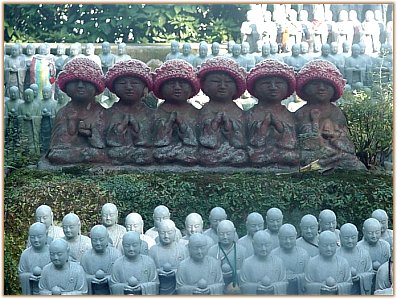
Roku Jizō (Six Jizō Statues) At Hase Dera in Kamakura
Jizō vowed to assist beings in each of the six realms of karmic rebirth, especially those in hell, the lowest state, where the opportunities to improve one’s karma are at all-time lows. Jizō is one of Japan’s most popular and venerated deities. Statues of the deity are found most often in graveyards and as protective stone markers in mountain passes and country byways. Jizō is also the guardian of deceased children, expectant mothers, firemen, travelers, and pilgrims. In Japan, groupings of six Jizō statues (one for each of the six realms) are quite common and often placed at busy intersections or oft-used roads to protect travelers and those in "transitional" states. Jizō also often carries a staff with six rings, which he shakes to awaken us from our delusions. The six rings likewise symbolize the six states of karmic rebirth and Jizō’s promise to assist all beings in those realms. In Japanese traditions, the six rings, when shaken, are also meant to make a sound and thus frighten away any insects or tiny animals in the direct path of the pilgrim, thus ensuring the pilgrim does not slay or accidentally kill any life form. In Chinese traditions, Jizō shakes the six rings to open the doors between the various realms. Click here to learn more about the Six Jizō.

六観音 ROKU KANNON. SIX KANNON.
See Kannon Page for More Details About the Six
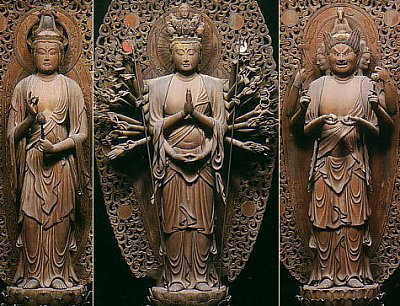
Shō Kannon 聖観音, Senju Kannon 千手観音, Batō Kannon 馬頭観音
Above and Below
Six Kannon 六観音 by Jokei II, Dated +1224
Wood, Treasures of Daihō-onji Temple 大報恩寺 (Kyoto)
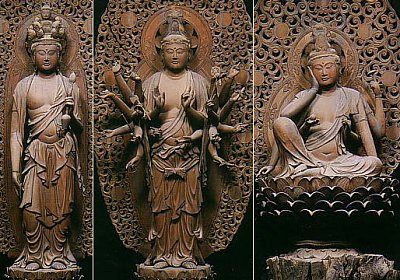
Jūichimen Kannon 十一面観音, Juntei Kannon 准胝観音, Nyoirin Kannon 如意輪観音

Significance of “Om Mani Padme Hum”
THE SIX-SYLLABLED MANTRA OF KANNON BODHISATTVA.
Below text courtesy of exoticindiaart.com/product/TM46/
- OM closes the door to the suffering of being reborn in the god (deva) realm. The suffering of the gods arise from foreseeing one's fall from the god's realm. This suffering comes from pride.
- MA closes the door to the suffering of being reborn in the warring gods (asuras) realm. The suffering of the asura is constant fighting. This suffering comes from jealousy.
- NI closes the door to the suffering of being reborn in the human realm. The suffering of humans is birth, sickness, old age, and death. This suffering comes from desire.
- PAD closes the door to the suffering of being reborn in the animal realm. The suffering of animals is stupidity, preying upon one another, being killed by men for meat, skins, etc., and being beasts of burden. This suffering comes from ignorance.
- ME closes the door to the suffering of being reborn in the hungry ghost realm. The suffering of hungry ghosts is hunger and thirst. This suffering comes from greed.
- HUM closes the door to the suffering of being reborn in the hell realm. The sufferings of hell are heat and cold. This suffering comes from anger or hatred.

WHEEL OF LIFE - Tibetan Tanka (Thangkas)
Tantric Buddhism (Vajrayana Buddhism) is practiced most widely today in Tibet. The Buddhist wheel of life, often the subject of the Tibetan Thanka (also spelled thangka), is one of the most common artistic representations of the Six States of Existence.

Courtesy of Fairhope Tibetan Society (see also fairhopetibetan.org)
For an illustrated review of the Wheel of Life, please click here
THREE ANIMALS
At the center of the wheel one finds three animals -- a pig, a snake and a rooster. The pig symbolizes greed (Skt. = lobha), the snake anger and hatred (Skt. = dosa) and the rooster (or cock) ignorance or delusion (Skt. = moha). The three animals are often shown biting each others tails, to show that these evils are inseparably connected. The emotions of the three stem from fundamental ignorance. Together, the triad represents the root causes of trouble on earth.
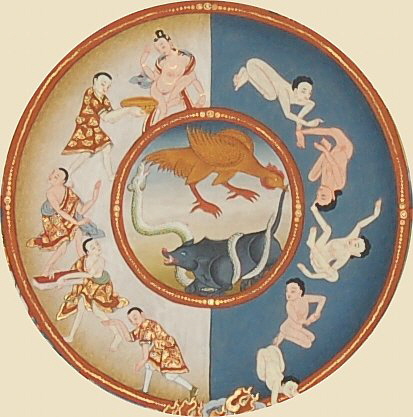
Closeup of center, Tanka in Schumacher’s private collection (see photo below)
At the center of the wheel one finds three animals -- a pig, a snake and a rooster.

Tanka in Mark Schumacher’s private collection.
The six worlds appear as six discreet sections linked to the center.

LEARN MORE
ARTWORK OF HUNGRY GHOSTS
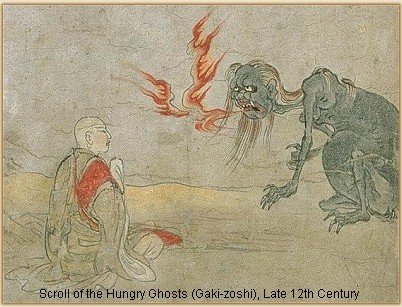
Learn more about this scroll (a “National Treasure”)
in the collection of the Kyoto National Museum; includes more photos
Scroll of the Hungry Ghosts (Gaki Zōshi 餓鬼草紙)
Late-Heian Period (Late-12th Century), National Treasure


Our sister estore offers numerous statues of Jizō Bosatsu
|
|